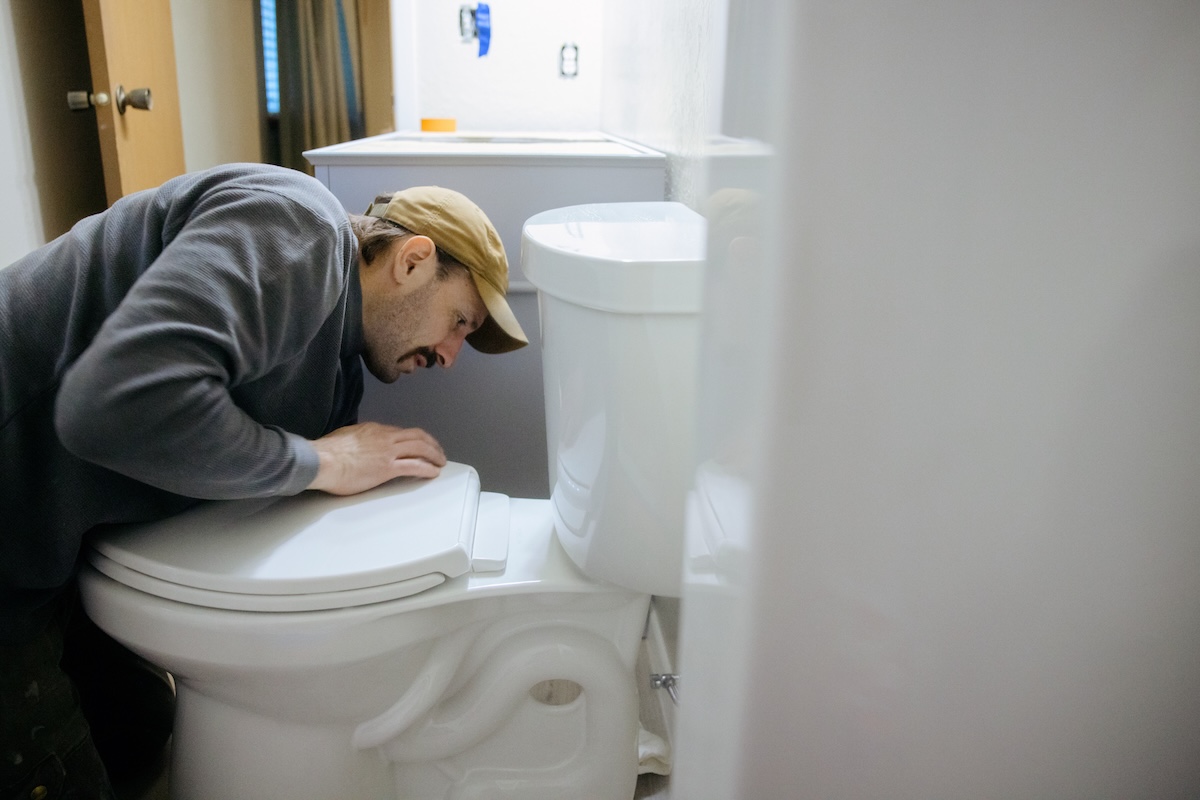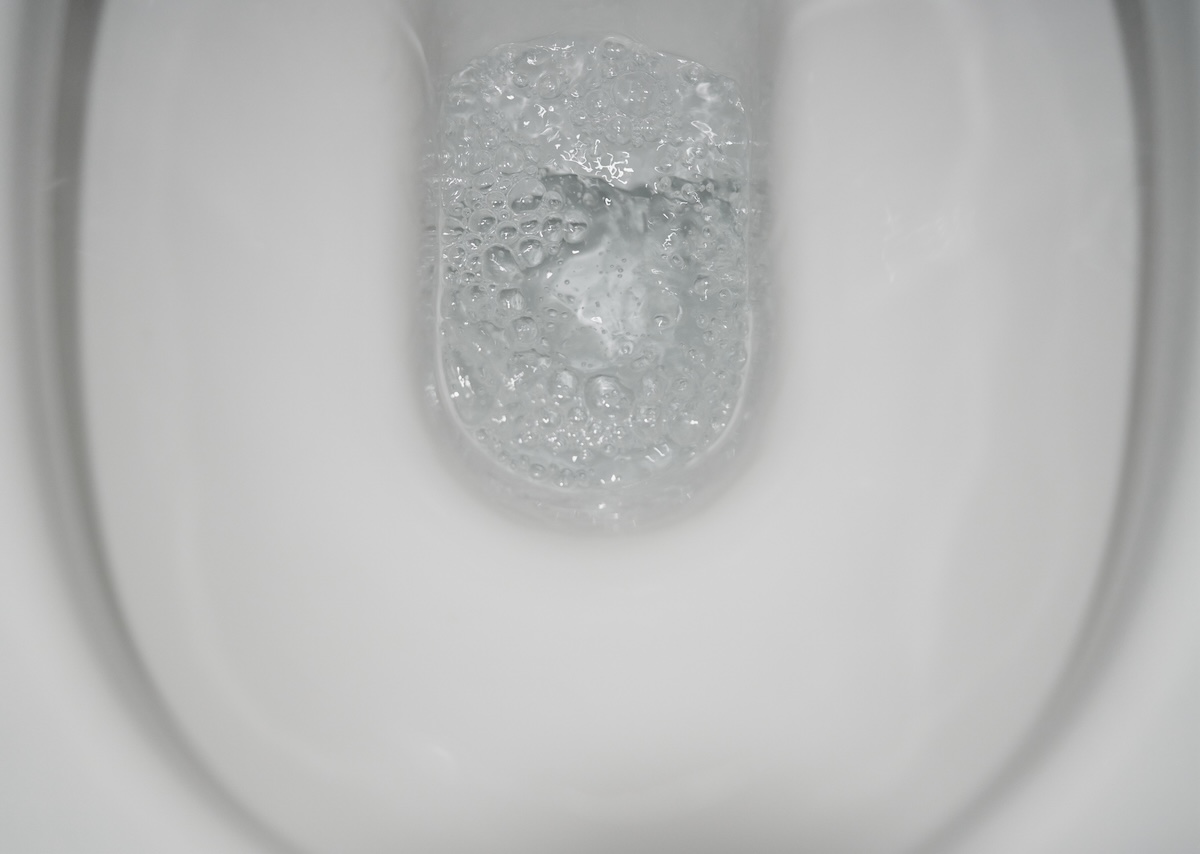We may earn revenue from the products available on this page and participate in affiliate programs. Learn More ›
While bubbling or gurgling is a relatively common toilet problem, it’s not an issue you want to ignore. When a toilet bubbles, it indicates that negative air pressure (suction) is building up in the drain line, creating an airlock of sorts. Most likely this buildup of air is due to a clog.
Depending on the severity of the clog, you may be able to clear it yourself with a plunger or an eco-friendly Drano alternative. Otherwise, you might have to call a plumber. Is a gurgling toilet dangerous? Not typically, but if the culprit is a broken or collapsed sewer line, it will have to be fixed—and the sooner the better. If the job is put off, waste could back up into toilets, showers, or tubs. The following guide will help you get to the root of toilet bubbling, and offer solutions to the problem.
Why Is My Toilet Gurgling and Bubbling?
In a well-functioning drain system, air flows freely through the lines, preventing negative air pressure, so waste runs smoothly down and out. However, a clog can block the flow of air, allowing negative air pressure to build up in the line. This negative air pressure will eventually release, pushing air backward through the drainpipe and into the toilet bowl. When this occurs, you’ll hear the toilet making a gurgling noise, and the water in the bowl may bubble. Some additional symptoms of a clog include the toilet not flushing, unpleasant smells, and waste backup.
Clogs typically occur in one of two areas: somewhere in the drain system, which could be close to the toilet or farther down the main sewer line that connects to your community’s sewer system, or in your home’s vent stack (the pipe that allows sewer gasses to escape through the roof). To fix the gurgling toilet once and for all, you’ll need to identify the location of the clog and take steps to remove it.
How to Fix a Bubbling Toilet

Addressing clogs is key to fixing air bubbles in your toilet—but not all clogs are created equal. A few troubleshooting steps can help you identify whether the solution is DIY-friendly, or if it’s time to call a plumber.
First, seal off nearby drains and try plunging.
If the cause of the gurgling is in the drainpipe, simply plunging the toilet might create enough pressure to dislodge a light-to-moderate clog. Bathroom fixtures (tub, sink, shower) often connect to the same drain line that runs from the toilet, so you’ll want to seal off these drains with duct tape before plunging. If you plunge without sealing the drains, the pressure plunging creates can escape through other drain fixtures instead of dislodging the clog.
Start by selecting the right plunger, such as the JS Jackson accordion-style plunger, which was a top pick in our researched guide to the best plungers. With the toilet bowl full of water, fit the head of the plunger tightly to the drain hole in the bottom of the bowl. Try to dislodge the clog with 10 to 15 firm pumping motions, then wait to see if the toilet gurgles again. If you don’t have a plunger handy, other ways of unclogging a toilet without one may be just as effective. However, if the gurgling continues, move on to the following steps.
Call your neighbors to see if their toilets are bubbling, too.
A clog in a community sewer line could be creating gurgling toilets in your neighbors’ homes as well. It’s worthwhile to contact your nearby neighbors to see if they also have noticed their toilet water bubbling, or similar issues like the toilet overflowing. If one or more of your neighbors is having plumbing concerns, call your municipal sewer authority and report the problem. They’ll send someone out to check the sewer main, and if that’s where the problem lies, they may even cover some of the expenses of repairing it.
Snake the drain to remove tougher clogs.
A sewer snake (also known as a plumber’s snake or plumber’s auger) can often remove tough clogs in a drainpipe that plunging can’t manage. Featuring a long cable and a head with cutting blades for chopping through stubborn clogs, the best drain snakes may even have a manual or motorized crank.
If you’re not sure how to snake a toilet, a manual toilet auger ($25 to $100 at home-improvement stores) is inserted into the toilet bowl. As you turn the crank, the head works its way down the drainpipe, cutting through clogs. This type of auger is limited to the distance of its cable reach, generally 5 to 15 feet.
If a clog is so deep in the drainpipe that a small sewer snake cannot reach it, you can upgrade to a motorized auger that will reach 50+ feet, or rent a medium-sized drain cleaner from a home improvement store. Renting the equipment for an afternoon might run you $40 to $50, whereas calling a plumber to snake the drain could run you $150 to $300. Additional repairs, such as removing tree roots from a sewer line or fixing a broken sewer line, may be even costlier.
Since the auger head on a motorized sewer snake is often too large to wind its way through the toilet bowl, the toilet should be removed from its base and the auger inserted into the drainpipe at floor level. When the machine is turned on, the auger will work its way down the line, its razor-sharp blades cutting through tough clogs.
For deeper clogs, snake the sewer cleanout line outside.

For clogs even deeper in the sewer line—as far out as the middle of your yard—you’ll want to auger the lines from the sewer cleanout, which is just outside of your home, directly over the sewer pipe. To locate the cleanout, check your basement or crawlspace to see where the main sewer line exits your house. Many cleanout pipes extend a few inches above the ground and feature a large PVC cap, but others may terminate just below ground level. You may need to do a little digging to uncover it. Once you’ve removed the cap from the cleanout pipe with an adjustable wrench, auger the sewer line from there. If the toilet gurgling stops, you’ve successfully removed the sewer clog that caused it; if the sounds continue, try troubleshooting the vent stack.
Check and clear the vent stack.
Because a home’s complex system of drainpipes requires an ample supply of air in order to prevent air locks in the pipes, a clog in the vent stack could be restricting airflow and causing the gurgle. This investigation can be performed before or after you snake the drain.
Checking and clearing the vent stack requires getting on the roof, so if you’re not completely comfortable with that, be safe and call the pros. Here’s how to check the vent stack yourself:
- First, locate the vent stack by looking for a cylindrical pipe sticking straight out of the roof.
- To confirm that you have the right pipe, have someone indoors flush the toilet while you listen for the sound at the opening of the pipe.
- Next, tie and then duct tape a powerful, narrow flashlight to the end of a rope, turn it on, and insert it into the uncapped pipe that exits through the top of the roof.
- Look for signs of a blockage. If the clog is within eight to 10 feet of the top of the pipe, you’ll often be able to see it.
Vent clogs are often caused by leaves and debris, or even the carcass of a small animal that got stuck in the pipe. If the clog is within a few feet of the top of the pipe, you may be able to remove it with a straightened-out wire coat hanger or one of the best toilet brushes. Deeper clogs can often be removed by running water from a garden hose in the pipe, which can dislodge the clog, washing it down the pipe and out through the sewer.
Call the plumber if your toilet bubbles despite these best efforts.
Can a gurgling toilet fix itself? Unfortunately, the answer is no. If the troubleshooting methods above failed to silence your gurgling toilet bowl, it’s time to call the plumber. Plumbers have specialized emergency plumbing tools and equipment, such as powerful sewer augers that can chop through anything blocking the main sewer line. According to Roto-Rooter, gurgling toilets can also indicate that tree roots have grown into the sewer line. If this is the case, repairs are best left to a professional plumber. Professionals can use mini cameras that drop into vent stacks to locate the source of the problem. There’s also a slim chance that the main sewer line in your yard has broken or collapsed, in which case excavation and professional repairs might be necessary.


